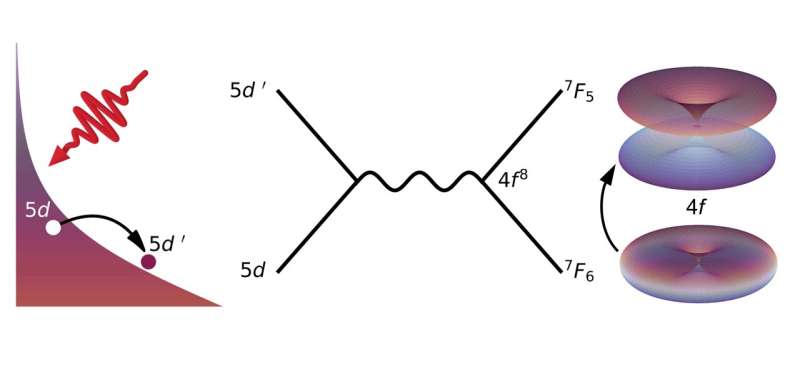This article has been reviewed according to Science X's editorial process and policies. Editors have highlighted the following attributes while ensuring the content's credibility:
fact-checked
peer-reviewed publication
trusted source
proofread
A new way to control the magnetic properties of rare earth elements

The special properties of rare earth magnetic materials are due to the electrons in the 4f shell. Until now, the magnetic properties of 4f electrons were considered almost impossible to control.
Now, a team from HZB, Freie Universität Berlin and other institutions has shown for the first time that laser pulses can influence 4f electrons- and thus change their magnetic properties. The discovery, which was made through experiments at EuXFEL and FLASH, opens up a new way to data storage with rare earth elements.
The strongest magnets we know of are based on rare earths. Their 4f electrons are responsible for their magnetic properties: They generate a large magnetic moment that is maintained even when their chemical environment changes. This means that rare earths can be used in very different compounds and alloys without changing their special magnetic properties.
Until now, it was assumed that the magnetic properties of 4f electrons could not be changed even if the material was excited with a laser pulse. But indeed, this is possible, as a team from HZB, Freie Universität Berlin, DESY, the European X-ray laser XFEL and other institutions has now shown.
The spatial arrangement of the 4f electrons can be briefly switched by laser excitation. This also changes their magnetism. This effect opens up new possibilities for the fast and energy-efficient control of magnetic rare-earth materials. The work has now been published in the journal Science Advances.
Terbium studied at the X-ray lasers EuXFEL and FLASH
The team carried out experiments at the X-ray lasers EuXFEL and FLASH and analyzed samples of terbium, a rare earth element with atomic number 65 and a total of 8 electrons in 4f orbitals. The sample was excited with an ultrashort laser pulse and analyzed by X-ray spectroscopy.
The soft X-ray radiation used in the study is able to determine the electronic structure of a material very sensitively. The experiment shows that after laser excitation, 4f electrons briefly switch to an orbital with a different spatial distribution. This is due to a scattering process with 5d electrons, which had not been considered before. The redistribution of the 4f electrons by the laser excitation causes a brief switch in their magnetic properties.
Rare earth materials as data storage devices
This controlled switching opens up new applications for rare earth materials, such as energy-efficient and fast information storage devices. Until now, rare earths have not been used in magnetic storage media.
The latest storage media are so-called HAMR (Heat-Assisted Magnetic Recording) data storage devices, in which magnetic structures are heated by a laser pulse in order to be switched by a magnet.
With the much stronger rare-earth magnets, an ultrashort laser pulse could now excite the 4f electrons and enable switching—an electronic effect that would be even faster and more efficient than the heating mechanism in HAMR memory.
High-resolution spectroscopy with ultrashort X-ray pulses at BESSY II
This research has been made possible by the development of accelerator-based X-ray sources for generating ultrashort X-ray pulses in recent decades. These X-ray sources allow to observe elementary processes in magnetic materials on time scales of a few femtoseconds. A femtosecond (10-15 s) is one millionth of a billionth of a second. Light travels by about a hair's breadth in 300 femtoseconds.
The work was carried out at the European X-ray laser EuXFEL and at FLASH in Hamburg. The HZB also operates a short-pulse X-ray source, which will be expanded by the end of this year specifically for experiments with high spectroscopic resolution. BESSY II will then also offer optimal conditions for this type of experiment. Berlin is one of the world's leading centers for research into ultrafast magnetic effects.
More information: Nele Thielemann-Kühn et al, Optical control of 4 f orbital state in rare-earth metals, Science Advances (2024). DOI: 10.1126/sciadv.adk9522
Journal information: Science Advances
Provided by Helmholtz Association of German Research Centres





















